2008 年北京普通高中会考英语真题及答案
第一部分(选择题 共 75 分)
考
生
须
知
1.考生要认真填写考场号和座位序号。
2.本试卷共 10 页,分为两部分。第一部分选择题,四道大题(共 75 分);第
二部分非选择题,两道大题(共 25 分)。
3.试题所有答案必须填涂或书写在答题卡上,在试卷上作答无效。第一部分
必须用 2B 铅笔作答;第二部分必须用黑色字迹的签字笔作答。
4.考试结束时,考生应将试卷和答题卡按要求放在桌面上,待监考员收回。
一、听力理解 (共 15 小题,15 分)
第一节:听下面八段对话或独白,从各题 A、B、C 三个选项中, 选出能回答问题的最佳答
案。每段对话或独白你将听两遍。
听下面一段对话,回答第 1 题。
1. What time is it?
A. 2:30.
B. 3:00.
C. 3:30.
听下面一段对话,回答第 2 题。
2. What does the woman ask the man to do?
A. Buy some chocolate.
B. Go shopping with her.
C. Wait for her in the store.
听下面一段对话,回答第 3 题。
3. What’s the man doing?
A. Offering help.
B. Giving advice.
C.
Making
a
decision.
听下面一段对话,回答第 4 题至第 5 题。
4. What’s the man’s problem?
A. His parents don’t like his friends.
B. His parents treat him like a child.
C. His parents don’t want to help him.
5. What does the woman advise the man to do?
A. To move out and live alone.
B. To have a talk with his parents.
C. To buy an apartment for his parents.
听下面一段对话,回答第 6 题至第 7 题。
6. What’s the woman doing now?
A. Typing a paper.
B. Having a meeting.
C. Taking a rest.
7. What will the man do for the woman?
A. Bring her some food.
B. Help her with her work.
C. Find more people
to help her.
听下面一段对话,回答第 8 题至第 9 题。
�
8. Why does the woman fly around the world?
A. To have an exciting adventure.
B. To visit different places of interest.
C. To collect money for sick children.
9. What does the woman say about her life now?
A. She feels much older.
B. She likes to live an active life.
C. She is lonely without her children.
听下面一段对话,回答第 10 题至第 12 题。
10. What does the club try to help the children with?
A. Sports and games.
B. Reading and writing.
C.
Painting
and
drawing.
11. What will the club members get this month?
A. A pen.
B. A video.
C. A magazine.
12. How much will a member pay for a year?
A. £3.
B. £5.
C. £6.
听下面一段独白,回答第 13 题至第 15 题。
13. What can you see at eight o’clock tonight?
A. Sports News.
B. Jim and Tim.
C. An insect’s life.
14. Why will Policewatch not be shown tonight?
A. The Scottish detective is ill.
B. The European Cup football match is on.
C. More people are interested in the jokes.
15. Who is talking here?
A. An insect scientist.
B. A theater advertiser.
C. A TV program hostess.
二、单项填空 (共 15 小题,15 分)
从各题 A、B、C、D 四个选项中,选出可以填入空白处的最佳答案。
16. —Shall we go out for ______ meal this evening?
—Yes, that’s ______ good idea.
A. a; a
B. a; the
C. the; a
D. the;
the
17. —Kate didn’t come to the movie with us last night.
—Why?
—Because she ______ study for a test.
A. ought to
B. used to
C. had to
D. was
able to
18. Willy owned ______ collection of books than anyone else I have ever met.
A. large
B. a larger
C. the largest
D. the
�
larger
19. It rained ______ the night and the road is still wet now.
A. at
on
B. during
C. within
D.
20. Fewer women these days ______ at home to look after their children.
A. stay
B. seem
C. become
D. appear
21. —When are you going to the bank?
—I’ll go there before I ______ to the post office tomorrow morning.
A. will go
B. am going
C. went
D. go
22. He sat down in the kitchen, but he ______ only one piece of bread when the phone
rang.
A. had eaten
B. ate
C. was eating
D.
would eat
23. Andy ______ down by a car yesterday. Luckily he ______ seriously.
A. was knocked; was hurt
C. was knocked; wasn’t hurt
B. knocked; was hurt
D. knocked; wasn’t hurt
24. I agree that FindingNemo is entertaining, ______ I like BrotherRear better.
A. so
B. but
C. or
D. and
25. ______ out of bed, he dressed so quickly that he put his boots on the wrong
feet.
A. Being jumped
B. To jump
C. Jumped
D. Jumping
26. —Do you like your math course?
—Yes. It’s ______ difficult, but I enjoy it.
A. too
B. little
C. very
D. not
27. My boss asked me ______ met Ms. Powell.
A. if I had
B. if had I
C. that I had
D. that had
I
28. Have you seen the movie ______ is playing at the Fox Theater?
A. it
B. which
C. 不填
D. what
29. These birds have such small wings that they cannot get into the air ______ they
try.
A. now that
B. as if
C. even if
D.
so
that
30. Before you accept this offer, please ______ it ______very carefully.
A. turn; down
think; over
B. carry; on
C. find; out
D.
三、完形填空 (共 15 小题,15 分)
阅读下面短文,从各题 A、B、C、D 四个选项中,选出可以填入空白处的最佳答案。
Under Water
June was sitting by the swimming pool in her new swimsuit. Feeling really hot,
else was in the pool. It was so good to have
33
her body immediately. She
32
she dived into the water.
the whole pool to herself. The fresh water
on swimming around the pool.
31
�
r
e
g
34
Not having swum in the past several years and being a bit out of shape, June
w
easily. “Ah, no pain no gain,” she thought to herself. June continued
. Then she
to swim, realizing her head was hurting. Her breathing became
saw the lifeguard and some others around the pool. No sense in embarrassing (使
尴 尬 )
s h e
b o t h e r i n g
h e r s e l f
a n y o n e ,
o r
35
36
on.
, she continued on.
Then June found herself in the middle of the pool. Deciding not to make a
37
she made it to the other side of the pool.
Tiredness and weakness made it difficult for June to get out of the pool. As she
39
, her body swayed (摇摆) back and forth, losing her
40
38
.
Realizing she needed help but unable to even say anything, she leaned against
the pool side. Several minutes later she had enough
to pull her body up
out of the pool. Sitting at the side of the pool, she felt that someone was
42
at her. It was the lifeguard. June was only able to wave her hand, telling him that
she was okay.
41
Have you ever found yourself in such a
and you don’t ask for help?
Maybe you’re afraid you’ll be made a laughing stock (笑柄). We’ve all been there.
There is nothing wrong in asking for help.
has many ups and downs. When
you find yourself unable to “keep your head above water,” stop, look around and
ask for help before you find yourself “ 45 ”. The journey of life will be
happier and more satisfying.
43
44
31. A. Everyone
B. Someone
C. Anybody
32. A. cleaned
B. cooled
33. A. kept
34. A. worried
B. lived
B. tired
35. A. deep
B. difficult
36. A. walked
37. A. mark
B. rode
B. face
C. filled
C. agreed
C. excited
C. free
C. raced
C. point
D. Nobody
D. washed
D. came
D. bored
D. quiet
D. swam
D. scene
38. A. Finally
B. Clearly
C. Suddenly
D. Immediately
39. A. landed
B. stood
40. A. sight
B. way
C. jumped
C. courage
41. A. energy
B. support
C. patience
D. dressed
D. balance
D. effort
42. A. aiming
B. shouting
C. staring
D. laughing
43. A. conclusion
B. decision
C. situation
D. consideration
44. A. Emotion
B. Theme
C. Life
D. Time
45. A. falling
B. drowning
C. hesitating
D. screaming
四、阅读理解 (共 15 小题,30 分)
阅读下面短文,从各题 A、B、C、D 四个选项中选出最佳答案。
A
Types of Maps
�
Different types of maps have different uses.
Tourist maps, for example, have signs to show
places of interest in an area. When tourists read
these maps, it is easy for them to find where to
go and what to see in a place and it is easy for
them to go and find their ways to these places.
Road maps show large areas so that people can plan
long journeys. Different types of roads are given
different numbers. For example, if you want to go
to Wood Green, you just follow No. 621 Road and keep
looking at the road signs.
Distribution maps (分布图) use colors or signs to
show facts about an area. For example, where
different languages are spoken, how many people
live in an area, how cold and hot some places are,
or whether a place is short of water.
Agricultural products
in Lakeside
wheat
corn
bean
rice
Some maps, such as railway maps, use straight lines
to show everything. This is easy for people to read.
Trains are fast. People don’t have to think about
small places they go past. They just need to know
the two ends of their trips.
46. Jim is visiting the Summer Palace. Which map does he need most?
A. A tourist map.
C. A distribution map.
B. A road map.
D. A railway map.
47. How can you tell different roads on road maps?
A. By using different colors.
C. By following No. 621 Road.
B. By finding the numbers.
D. By looking at the road signs.
48. Which of the following can distribution maps tell us?
A. How to get to Germany.
C. Where a famous museum is.
B. How to plan a long journey.
D. Which place is short of water.
49. Why do railway maps use straight lines?
A. Because railways are straight.
B.
Because
people
like
straight lines.
C. Because people can read them easily.
D. Because railways have
only two ends.
B
�
There are many kinds of heroes. Even animals can be heroes. This month’s
newsletter tells about three amazing animals. Each one is a hero!
Thumper the Dog
Thumper was a dog that lived with a family which had a
three-year-old son named Benjamin. One day Benjamin wandered into a
large field. The grass in the field was taller than he was, so he could
not find his way out. Hundreds of people began to search for Benjamin.
When they found him, they saw Thumper stayed with Benjamin and kept him warm. So
Benjamin had stayed safe and calm.
Lulu the Pig
The Altsmans had a pet pig named Lulu. One summer the couple went
camping and took Lulu with them. The husband went fishing one morning.
The wife didn’t feel well, so she and Lulu stayed in the camper.
Suddenly Mrs. Altsman fell to the floor. Lulu pushed the camper door
open and climbed out to locate help. When a car came by, she lay down
in front of it. When the driver got out, Lulu led him back to the camper. The man
called for help and Mrs. Altsman was taken to hospital.
Sugar the Cat
Sugar was a beautiful cat. Three years ago she wandered onto the
Woods’ farm in California and Mrs. Woods began feeding her. Mrs. Woods
noticed something wrong with the cat’s left leg, but this didn’t make
Sugar any less special. Mrs. Woods loved Sugar. Later the couple moved
to a new farm in Oklahoma. They gave Sugar to a neighbor who would take
good care of her, because they knew she wouldn’t like riding in cars for days.
However, Sugar walked across deserts and mountains and traveled more than 1,500
miles to the Woods’ new farm! Mr. and Mrs. Woods could hardly believe their eyes.
No one knows how Sugar found her way to Oklahoma.
50. What is the passage mainly about?
A. Lovely pigs.
C. New friends.
B. Unknown heroes.
D. Amazing animals.
51. How did Thumper help Benjamin?
A. By searching for him in the field.
B. By finding the way out for him.
C. By staying with him all the time.
D. By cutting the grass around him.
52. Why did Lulu lie down on the road?
A. To get help.
C. To have a sleep.
B. To watch the cars.
D. To ask for a lift.
53. What did Sugar do in the story?
A. Sugar tried to find help.
B. Sugar protected her owners.
C. Sugar went camping with her owners.
�
D. Sugar went a long way to find her owners.
C
Frederick Law Olmsted
Frederick Law Olmsted was born on April 26, 1822, and grew to become
nineteenth-century America’s number one landscape (景观) architect. Bad eyesight
forced him to abandon his plans to attend university, so he had to choose a new
course for his life. As a boy in Hartford, Connecticut, he had always admired natural
beauty. So, instead of studying academics, he decided to focus on engineering and
farming. In the 1850s, he ended up in charge of creating Central Park in New York
City.
Olmsted and a partner entered a design contest for a new park and won with a
design patterned after gardens and natural landscapes that Olmsted had seen and
admired around the world. To create the new park, they removed nearly 5 million
cubic yards of dirt, blew up rock with 260 tons of gunpowder, and planted 270,000
trees and shrubs. In 1864, New Yorkers could have walks along wooded paths, paddle
a boat around the lake, or people-watch from the hills. Today, many people cannot
imagine New York City without its Central Park.
Maybe it was watching those people enjoy his creation that inspired Olmsted.
He became one of the first members of designing committee of Yosemite National Park
because he was determined to protect its breathtaking beauty. He did the same for
Niagara Falls and helped turn it into a public reserve. Working well into his
seventies, Olmsted designed more parks and even an entire Chicago suburb (郊区),
Riverside. And to think that bad eyesight led him to create such beautiful places!
54. Which of the following shows what Olmsted did in time order?
a. He studied engineering and farming.
b. He took charge of creating Central Park.
c. He gave up his plans to go to university.
d. He took part in the designing of Yosemite National Park.
e. He designed a Chicago suburb.
A. a-c-b-d-e
B. a-c-d-e-b
C. c-a-b-d-e
c-a-e-b-d
55. Which statement would Frederick Law Olmsted agree to?
A. It is not necessary for young people to go to university.
B. Money provided for public parks should be reduced.
C. Beauty of the natural land should be protected.
D. It is a waste of time entering design contests.
56. We can infer from the passage that ______.
A. Olmsted designed the breathtaking Niagara Falls
B. Olmsted traveled a lot before designing Central Park
C. Olmsted’s poor eyesight contributed to his great creations
D. Olmsted majored in engineering and farming in university
D
D.
�
Train-spotting
Many people around the world have seen Danny Boyle’s movie Trainspotting
starring Ewan McGregor, but how many of us really know what train-spotting is all
about? Now this is not considered cool in town and the word “train-spotter” in
Britain is related to “geek” or “nerd” (someone who seems very ridiculous).
But is this reputation really deserved?
First of all, let’s see what train spotting is. It is said that there are some
100,000 train spotters in the UK. Exactly as the title suggests, they spot trains,
that is, they stand in train stations, look at the number of each train that leaves
and arrives and write it down. The eventual aim is to have seen every train in the
country.
Being crazy about railways and trains is not modern and it dates back to 1804.
As the number of trains grew and they got faster and faster, so did the interest
in them grow. Is this any stranger than people who love cars?
So, what do you need to be a train-spotter? Well, all you really need is a pen
or pencil and a notebook to write down the train numbers. Other equipment includes
hot tea in a thermos, a camera and some sandwiches for those long afternoons spent
on train platforms when you don’t want to risk the delights of railway station
food.
It’s interesting to note that despite the “bad name” of train-spotting, there
have been famous railway lovers in history, such as Alfred Hitchcock, who filmed
them regularly, especially The 39 Steps. There is evidence, too, that being a
train-spotter is not necessarily a strange phenomenon in Britain.
One glance at the US train stations should be enough to convince you that
train-spotters there are alive and well. In America, they try to call rail lovers
“train-fans” and talk of “train-fanning”. Don’t let this fool you—these people
are train spotters and there are a lot of them. Each month, two million pages are
visited on the website TrainWeb.org.
57. According to the author, what is train-spotting?
A. A way of pastime.
C. A strange phenomenon.
B. A type of sport.
D. A mental problem.
58. What do train-spotters usually do?
A. They keep a careful track of every train.
B. They number each railway engine they view.
C. They count the trains passing in front of them.
D. They produce films about trains with video cameras.
59. The author writes the article to ______.
A. introduce some famous train-spotters
B. encourage readers to do more train-spotting
C. try to present a true picture of train-spotting
D. describe the necessary equipment in train-spotting
60. What do we learn from the passage?
A. Train-spotters are much stranger than car lovers.
B. Train-spotting relates to a dangerous lifestyle.
�

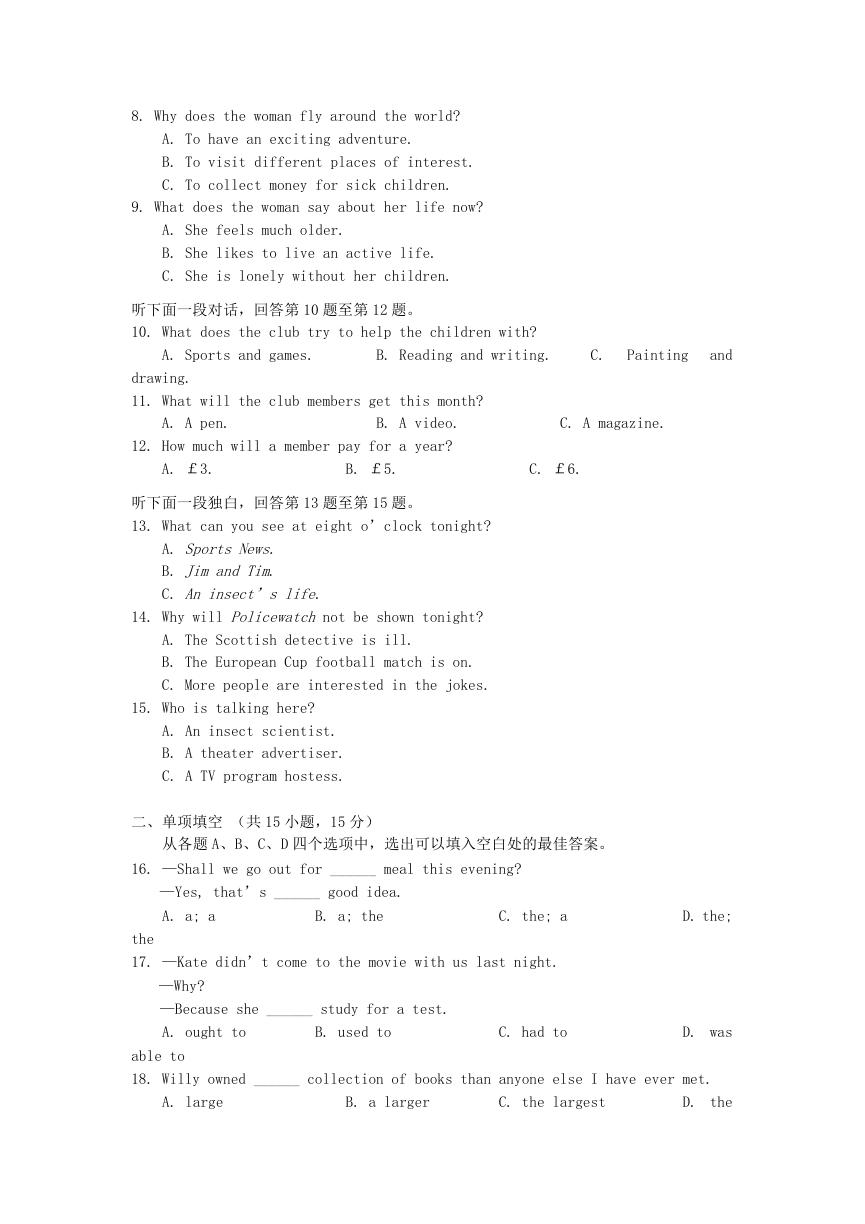
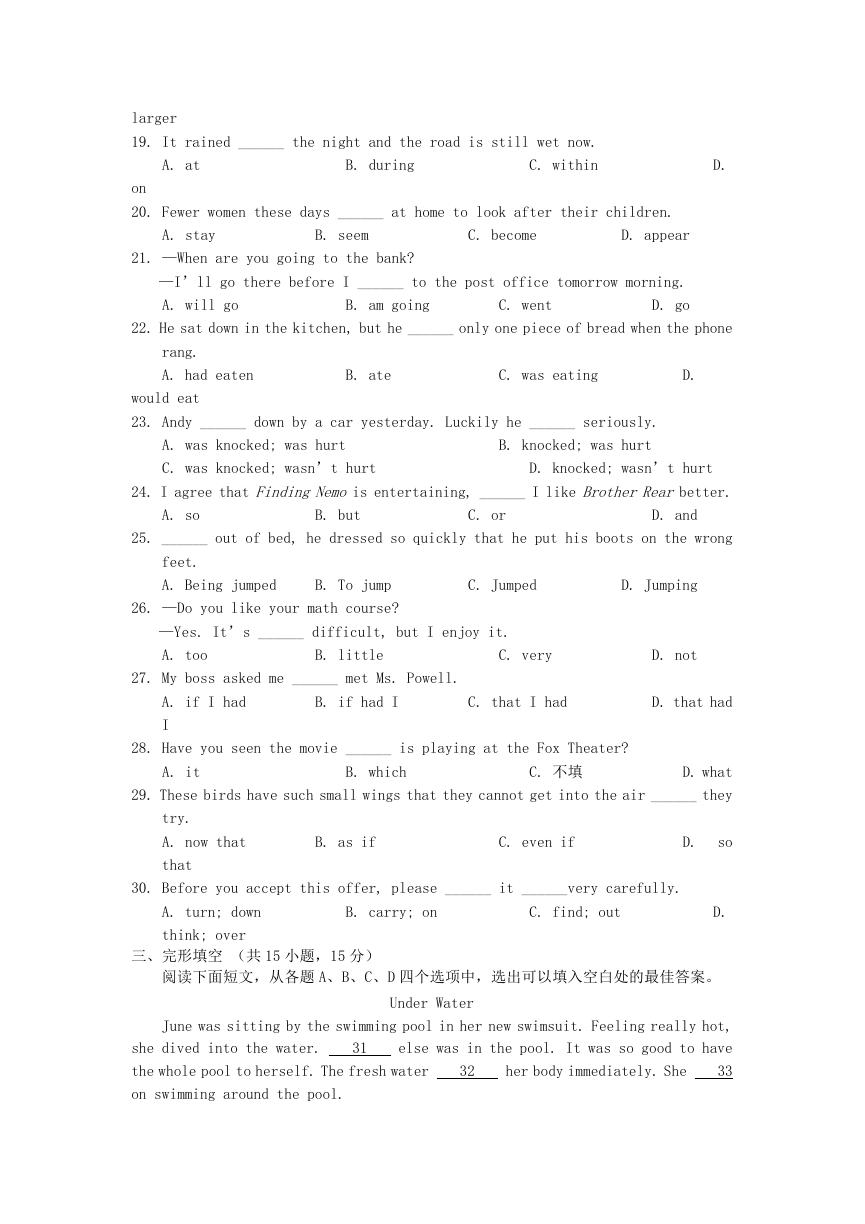
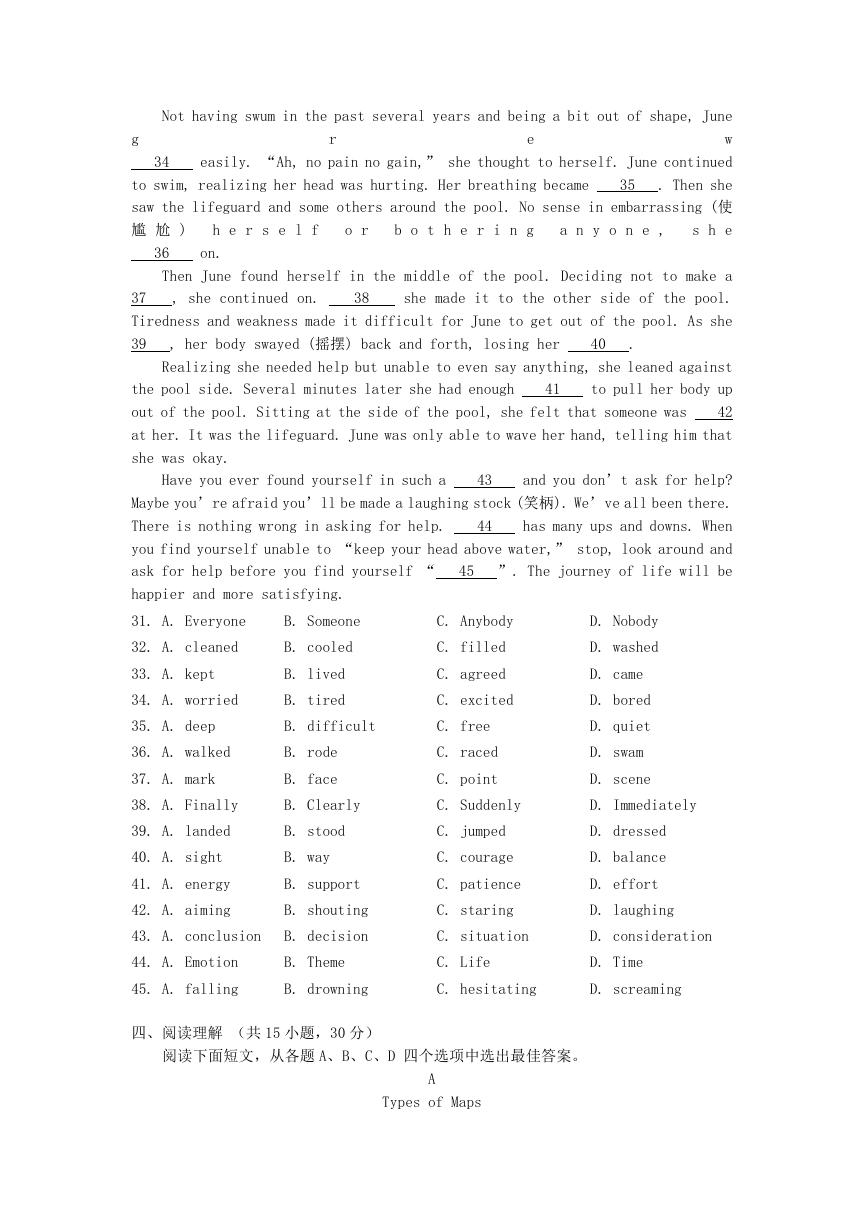
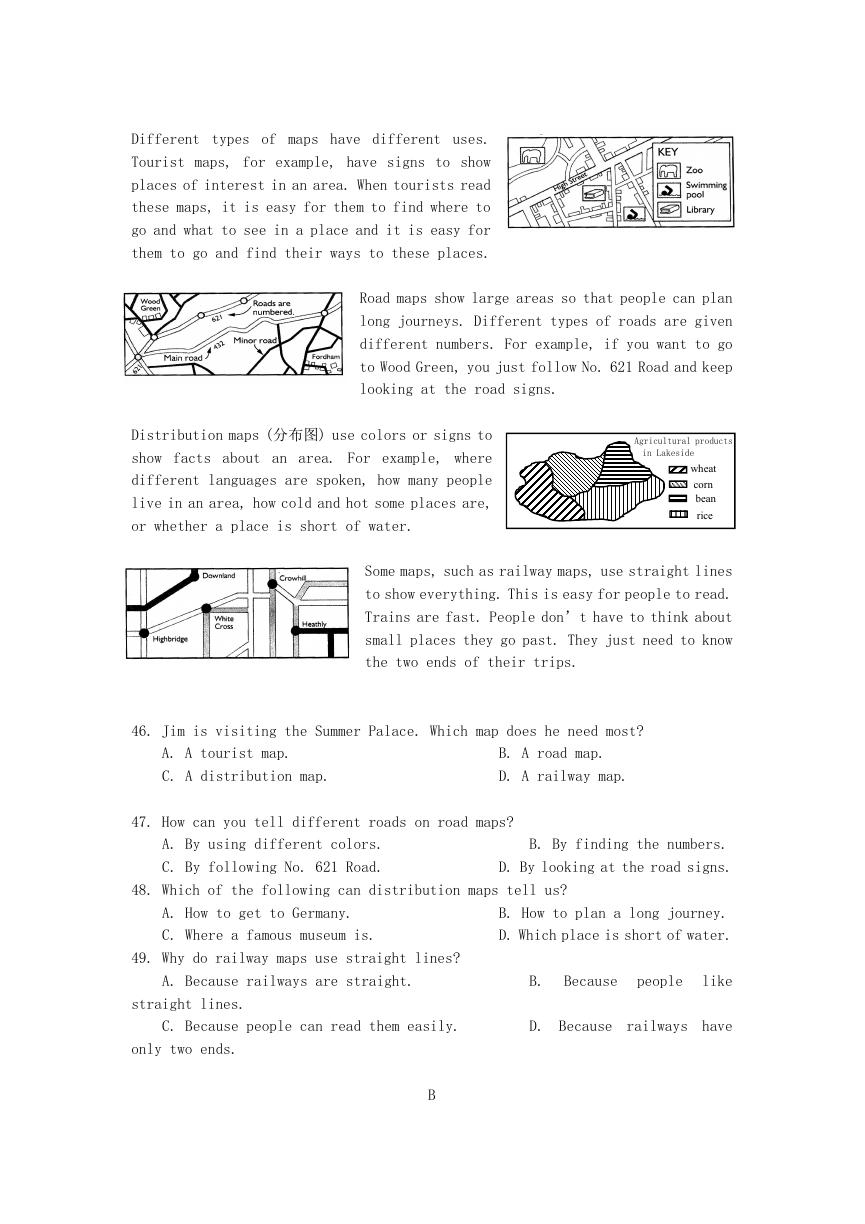
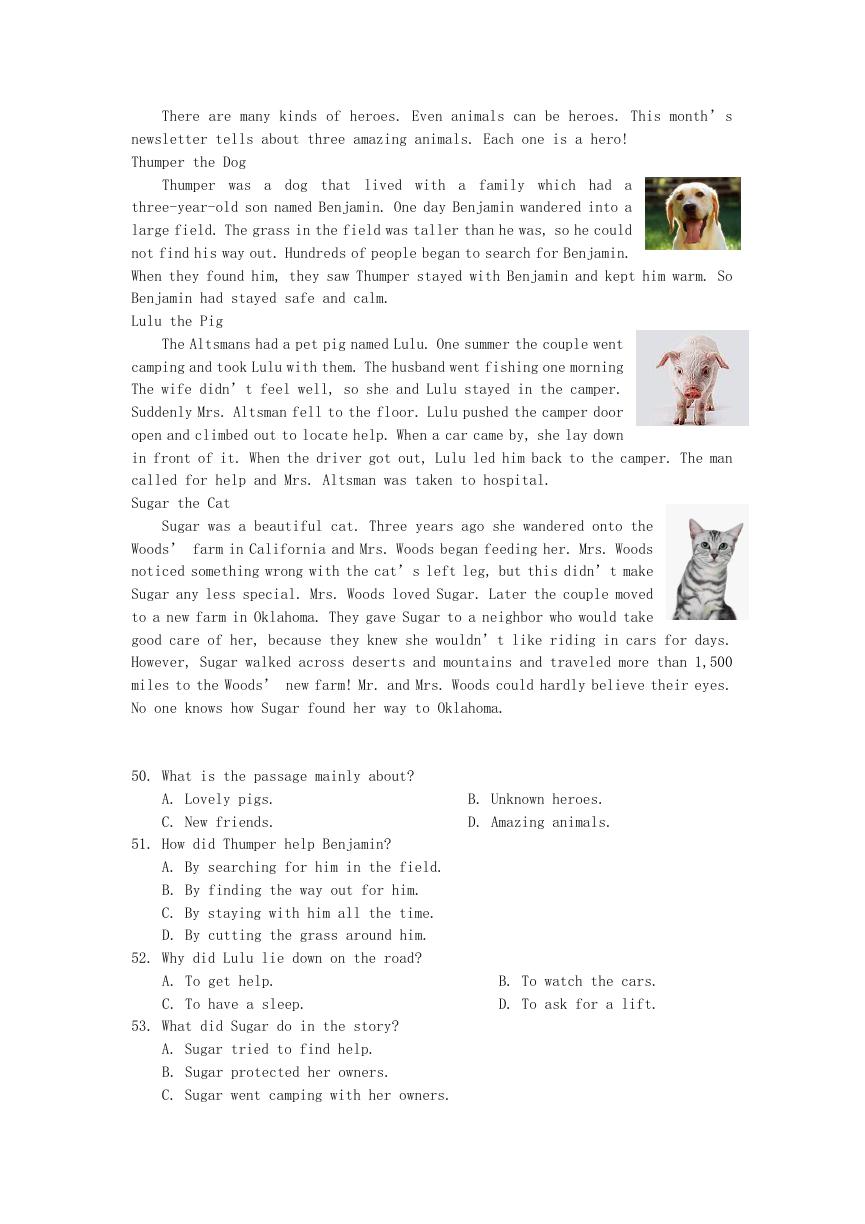










 2023年江西萍乡中考道德与法治真题及答案.doc
2023年江西萍乡中考道德与法治真题及答案.doc 2012年重庆南川中考生物真题及答案.doc
2012年重庆南川中考生物真题及答案.doc 2013年江西师范大学地理学综合及文艺理论基础考研真题.doc
2013年江西师范大学地理学综合及文艺理论基础考研真题.doc 2020年四川甘孜小升初语文真题及答案I卷.doc
2020年四川甘孜小升初语文真题及答案I卷.doc 2020年注册岩土工程师专业基础考试真题及答案.doc
2020年注册岩土工程师专业基础考试真题及答案.doc 2023-2024学年福建省厦门市九年级上学期数学月考试题及答案.doc
2023-2024学年福建省厦门市九年级上学期数学月考试题及答案.doc 2021-2022学年辽宁省沈阳市大东区九年级上学期语文期末试题及答案.doc
2021-2022学年辽宁省沈阳市大东区九年级上学期语文期末试题及答案.doc 2022-2023学年北京东城区初三第一学期物理期末试卷及答案.doc
2022-2023学年北京东城区初三第一学期物理期末试卷及答案.doc 2018上半年江西教师资格初中地理学科知识与教学能力真题及答案.doc
2018上半年江西教师资格初中地理学科知识与教学能力真题及答案.doc 2012年河北国家公务员申论考试真题及答案-省级.doc
2012年河北国家公务员申论考试真题及答案-省级.doc 2020-2021学年江苏省扬州市江都区邵樊片九年级上学期数学第一次质量检测试题及答案.doc
2020-2021学年江苏省扬州市江都区邵樊片九年级上学期数学第一次质量检测试题及答案.doc 2022下半年黑龙江教师资格证中学综合素质真题及答案.doc
2022下半年黑龙江教师资格证中学综合素质真题及答案.doc